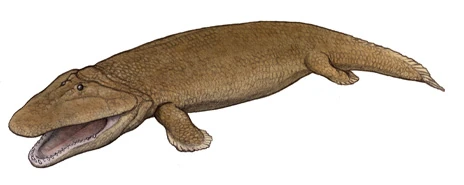The quest to determine the first land animal on Earth takes us back hundreds of millions of years, delving into the depths of paleontology and evolutionary biology. Understanding this topic not only sheds light on the origins of terrestrial life but also provides insight into how life on our planet has evolved over eons.
The transition from water to land is one of the most significant events in Earth's history. This transformation began during the Devonian period, around 375 million years ago, when early vertebrates started to adapt to terrestrial environments. These adaptations were crucial for survival, leading to the development of limbs and lungs, enabling organisms to move onto land.
While it's challenging to pinpoint a single "first" land animal, the earliest known terrestrial vertebrates are thought to be tetrapods. These creatures evolved from lobe-finned fish, which began to exploit shallow water environments. Fossils from this period, such as those of Tiktaalik and Acanthostega, provide evidence of the transitional features between aquatic and terrestrial life.
Tiktaalik roseae, discovered in 2004 in Canada, is often cited as a pivotal species in the transition from water to land. This ancient fish had both aquatic and terrestrial characteristics, such as gills and lungs, along with robust fins that resembled limbs. Tiktaalik lived approximately 375 million years ago, making it one of the earliest known tetrapods. Its anatomy demonstrates the gradual changes that allowed vertebrates to thrive on land.

Acanthostega is another crucial species in this evolutionary narrative, living around the same time as Tiktaalik. Unlike Tiktaalik, Acanthostega had fully formed limbs, but its adaptations were still primarily suited for life in water. It possessed eight digits on its limbs, suggesting that the evolution of fingers and toes was an ongoing process during this period.

While Tiktaalik and Acanthostega represent the transitional phase, the first true land animals likely emerged during the Carboniferous period (around 360 to 300 million years ago). Among these were early amphibians, such as Eryops, which began to exhibit more advanced adaptations for a terrestrial lifestyle, including better limb structure and skin capable of preventing desiccation.
It's essential to note that while tetrapods are often highlighted, the first land animals could also include terrestrial arthropods, such as millipedes and scorpions, which appeared around 450 million years ago during the Ordovician period. These invertebrates were among the first to colonize land, showcasing the diverse pathways of evolution that occurred during this crucial time.

The emergence of land animals had a profound impact on Earth's ecosystems. As these creatures adapted to terrestrial environments, they began to influence plant life, soil formation, and nutrient cycles. The evolution of land animals paved the way for the complex web of life we see today, including mammals, birds, reptiles, and ultimately humans.
Determining the first land animal on Earth involves understanding a complex tapestry of evolutionary changes. From the pioneering adaptations of early tetrapods like Tiktaalik and Acanthostega to the emergence of true land vertebrates and arthropods, the journey onto land has shaped the course of life on our planet. This evolutionary milestone serves as a reminder of the resilience and adaptability of life, highlighting the intricate connections that bind all living organisms.
1. What characteristics define early land animals?
Early land animals displayed adaptations such as limbs for movement, lungs for breathing air, and skin capable of preventing water loss.
2. Are there any living descendants of the first land animals?
Yes, modern amphibians, reptiles, birds, and mammals all trace their ancestry back to these early terrestrial creatures.
3. How did the transition to land impact animal evolution?
The transition allowed for the diversification of species and the colonization of various terrestrial habitats, leading to the complex ecosystems we see today.
By understanding the origins of terrestrial life, we gain valuable insights into our own place within the natural world and the ongoing story of evolution.
animal tags: first-land-animal
We created this article in conjunction with AI technology, then made sure it was fact-checked and edited by a Animals Top editor.